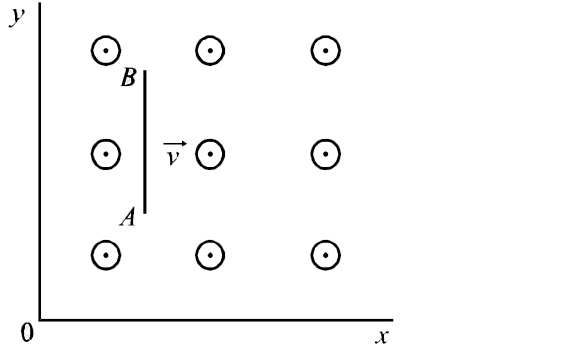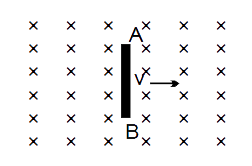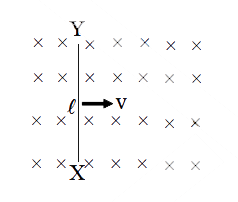A conducting rod AB moves parallel to the x-axis (see Fig.) in a uniform magnetic field pointing in the positive z-direction. The end A of the rod gets positively charged.
 .
.
According to Fleming's left hand rule, free electrons in rod experience force along AB. Therefore, end A acquires positive charge and end B acquries negative charge.
Topper's Solved these Questions
- BOOK - PRADEEPCHAPTER - ELECTROMAGNETIC INDUCTION & ALTERNATING CURRENTEXERCISE - Solved Examples (b)1videos
ELECTROMAGNETIC INDUCTION & ALTERNATING CURRENT
- BOOK - PRADEEPCHAPTER - ELECTROMAGNETIC INDUCTION & ALTERNATING CURRENTEXERCISE - Short Answer Qusetions2videos
ELECTROMAGNETIC INDUCTION & ALTERNATING CURRENT
- BOOK - PRADEEPCHAPTER - DUAL NATURE OF RADIATION AND MATTEREXERCISE - Exercise191videos
DUAL NATURE OF RADIATION AND MATTER
- BOOK - PRADEEPCHAPTER - ELECTROMAGNETIC WAVESEXERCISE - II Focus multiple choice question5videos
ELECTROMAGNETIC WAVES
Similar Questions
An electron in moving along positive x-axis in the presence of uniform magnetic field along positive y-axis. What is the direction of the force acting on it ?
View SolutionA proton is placed in a uniform electric field directed along the positive x-axis . In which direction will it tend to move?
View Solution
Knowledge Check
- Question 1 - Select One
A conductor rod AB moves parallel to X-axis in a uniform magnetic field, pointing in the positive Z-direction. The end A of the rod gets-
 Apositively chargedBnegatively chargedCneutralDfirst positively charged and then negatively charged.
Apositively chargedBnegatively chargedCneutralDfirst positively charged and then negatively charged. - Question 2 - Select One
A conducting rod AB moves parallel to x-axis in a uniform magnetic field pointing perpendicular and into the plane of paper. The end A of the rod
 Agets positively chargedBgets negatively chargedCremains neutralDgets positively charged first and then negatively charged
Agets positively chargedBgets negatively chargedCremains neutralDgets positively charged first and then negatively charged - Question 3 - Select One
A conducting rod AB moves parallel to x-axis in the x-y plane. A uniform magnetic field B pointing normally out of the plane exists throughout the region. A force F acts perpendicular to the rod, so that the rod moves with uniform velocity v. The force F is given by (neglect resistance of all the wires)
 AvB2l2Re−t/RCBvB2l2RCvB2l2R(1−e−t/RC)DvB2l2R(1−e−2t/RC)
AvB2l2Re−t/RCBvB2l2RCvB2l2R(1−e−t/RC)DvB2l2R(1−e−2t/RC)
An infinte wire place along z-axis has current I in positive z-direction A conducting rod placed in xy plane paralle to y-axis has current I2 in positive y-direction The ends of the rod subtend +30∘ and −60∘ at the origin with positive x direction The rod is at a distance a from the origin. Find net force on the rod .
View SolutionA rod AB moves with a uniform velocity v in a uniform magnetic field as shown in figure.
 View Solution
View SolutionA small conducting rod of length l, moves with a uniform velocity v in a uniform magnetic field B as shown in fig __
 View Solution
View SolutionA conducting rod of length l is moving in a transverse magnetic field of strength B with veocity v. The resistance of the rod is R. The current in the rod is
View SolutionAn electron having a charged e moves with a velcoity v in postive x direction. A magnetic field acts on it in positive y direction. The force on the electron acts in (where outward direction is taken as positive z-axis)
View Solution

